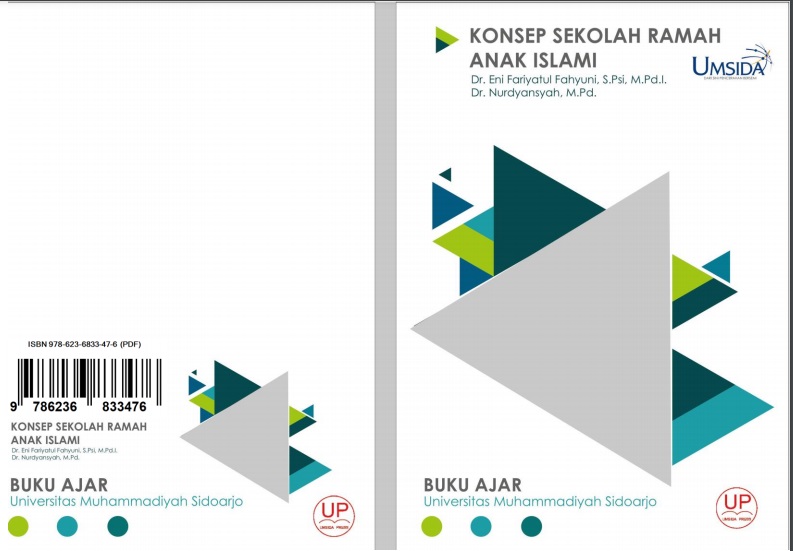Buku Ajar Konsep Sekolah Ramah Anak Islami
DOI:
https://doi.org/10.21070/2020/978-623-6833-47-6Keywords:
Buku Ajar, Konsep Sekolah, Ramah, Anak IslamiAbstract
Puji syukur penyusun panjatkan kehadirat Allah Swt atas rahmat, hidayah serta inayahNya buku ajar mahasiswa yang berjudul “Konsep Sekolah Ramah Anak Islami” dapat terselesaikan dengan baik. Penulis mengucapkan terimakasih yang sebesarbesarnya kepada: 1. Dr. Istikomah, M.Ag selaku Dekan Fakultas Agama Islam yang memberikan arahan dan motivasi kepada penulis dalam menyelesaikan buku ajar 2. Dr. Budi Haryanto, M.Pd selaku Kaprodi Magister Manajemen Pendidikan Islam yang telah memberikan dukungan guna terselesaikannya buku ajar ini 3. Rekan-rekan dosen pengajar pada Mata Kuliah Pengembangan Kurikulum Pendidikan Islam yang berbagi pengalaman dalam mata kuliah tersebut Saran dan kritik sangat penulis harapkan untuk mewujudkan buku ajar “Konsep Sekolah Ramah Anak Islami” yang lebih baik dan sesuai dengan amanah pemerintah. Amin
Downloads
References
Agbarachi Opara, J., & Silas Oguzor, N. (2011). Inquiry Instructional Method and the School Science Currículum. Current Research Journal of Social Sciences, 3(3), 188–198.
Atif, Y., Mathew, S. S., & Lakas, A. (2015). Building a smart campus to support ubiquitous learning. Journal of Ambient Intelligence and Humanized Computing, 6(2), 223–238. https://doi.org/10.1007/s12652-014-0226-y
Chin, K.-Y., & Chen, Y.-L. (2013). A Mobile Learning Support System for Ubiquitous Learning Environments. Procedia - Social and Behavioral Sciences, 73, 14–21. https://doi.org/10.1016/j.sbspro.2013.02.013
Fahyuni, E. (2018). Bimbingan Konseling Islami di Sekolah (1ed.). Sidoarjo: Umsida Press.
Maoto, S. (2014). Creating a child friendly psychosocial learning environment in mathematics: A case of problem solving in grade 6. Mediterranean Journal of Social Sciences, 5(23), 1048–1055. https://doi.org/10.5901/mjss.2014.v5n23p1048
Nuraeni, L., Andrisyah, A., & Nurunnisa, R. (2019). Efektivitas Program Sekolah Ramah Anak dalam Meningkatkan Karakter Anak Usia Dini. Jurnal Obsesi : Jurnal Pendidikan Anak Usia Dini, 4(1), 20. https://doi.org/10.31004/obsesi.v4i1.204
Claessens, L. C. A., van der Want, A. C., & van Tartwijk, J. (2018). Interpersonal adaptation in teacherstudent interaction. Learning and Instruction, 55,41–57. https://doi.org/10.1016/j.learninstruc.2017.09.005116
Agbarachi Opara, J., & Silas Oguzor, N. (2011). Inquiry Instructional Method and the School Science Currículum. Current Research Journal of Social Sciences, 3(3), 188–198.
Aritonang, S. D., Hastuti, D., & Puspitawati, H. (2020). Pengasuhan Ibu, Keterlibatan Ayah Dalam Pengasuhan, dan Perkembangan Kognitif Anak Usia 2-3 Tahun di Wilayah Prevalensi Stunting. Jurnal Ilmu Keluarga & Konsumen, 13(1), 38–48.
Atif, Y., Mathew, S. S., & Lakas, A. (2015). Building a smart campus to support ubiquitous learning. Journal of Ambient Intelligence and Humanized Computing, 6(2),223–238. https://doi.org/10.1007/s12652-014-0226-y
Chin, K.-Y., & Chen, Y.-L. (2013). A Mobile Learning Support System for Ubiquitous Learning Environments. Procedia - Social and Behavioral Sciences, 73, 14–21.https://doi.org/10.1016/j.sbspro.2013.02.013
Çobanoğlu, F., Ayvaz-Tuncel, Z., & Ordu, A. (2018). Childfriendly schools: An assessment of secondary schools.Universal Journal of Educational Research, 6(3), 466–477. https://doi.org/10.13189/ujer.2018.060313
Fahyuni, E. (2018). Bimbingan Konseling Islami di Sekolah (1ed.). Sidoarjo: Umsida Press.
Fariyatul, E., & Bandono, A. (2017). The use of value clarification technique-based- picture story media as an alternative media to value education in primary school.
Harmonia: Journal of Arts Research and Education 17(1), 68. https://doi.org/10.15294/harmonia.v17i1.7469
Hermino, A. (2017). Child-Friendly School in Educational 117 Settings for Elementary School in the Papua Island of Indonesia. Global Journal of HUMAN-SOCIAL SCIENCE: G Linguistics & Education, 17(1), 48–60.
Leino, M. (2011). The child friendly school: an idea versus reality. Problems of education in the 21st century, 29, 82–88.
Lin, Y. (2012). Adopting Creative Pedagogy into Asian Classrooms? –Case Studies of Primary School Teachers’ Responses and Dilemma. Journal of Education andLearning, 1(2), 205–216. https://doi.org/10.5539/jel.v1n2p205
Maisari, S., & Purnama, S. (2019). Peran Digital Parenting Terhadap Perkembangan Berpikir Logis Anak Usia 5-6 Tahun Di Ra Bunayya Giwangan. AWLADY : Jurnal Pendidikan Anak, 5(1), 41. https://doi.org/10.24235/awlady.v5i1.4012
Maoto, S. (2014). Creating a child friendly psychosocial learning environment in mathematics: A case of problem solving in grade 6. Mediterranean Journal of Social Sciences, 5(23), 1048–1055. https://doi.org/10.5901/mjss.2014.v5n23p1048
Mouri, Kousuke; Uosaki, Noriko; Ogata, H. (2018). Learning Analytics for Supporting Seamless Language Learning using E- book with Ubiquitous Learning System. Educational Technology & Society, 21(2), 150–163. https://doi.org/10.1007/springerreference_226192
Nuraeni, L., Andrisyah, A., & Nurunnisa, R. (2019). Efektivitas Program Sekolah Ramah Anak dalam Meningkatkan Karakter Anak Usia Dini. Jurnal Obsesi : Jurnal Pendidikan Anak Usia Dini, 4(1), 20. https://doi.org/10.31004/obsesi.v4i1.204
Orkodashvili, M. (2013). Quality Education through ChildFriendly Schools: Resource Allocation for the Protection 118 of Children’s Rights. SSRN Electronic Journal, 5(1), 101–109. https://doi.org/10.18662/rrem/2013.0501.07
Pennings, H. J. M., Brekelmans, M., Sadler, P., Claessens, L. C. A., van der Want, A. C., & van Tartwijk, J. (2018). Interpersonal adaptation in teacher-student interaction. Learning and Instruction, 55, 41–57. https://doi.org/10.1016/j.learninstruc.2017.09.005
Purwati, N., Zubaidah, S., Corebima, A. D., & Mahanal, S. (2018). Increasing Islamic Junior High School students learning outcomes through integration of science learning and Islamic values. International Journal of Instruction, 11(4), 841–854. https://doi.org/10.12973/iji.2018.11453a
RI, K. A. (2012). Al Qur’an Terjemah (T. S. Qur’an, ed.). Bandung: Syaamil Qur’an.
Saat, S. (2010). Pendidikan Anak Dalam Al Qur’an. Lentera Pendidikan, 13(1), 64–77.
Setyastuti, Y., Suminar, J. R., Hadisiwi, P., & Zubair, F. (2019). Millennial moms: Social media as the preferred source of information about parenting in Indonesia. Library Philosophy and Practice, 2019.
Sholeh, M. (2018). Pendidikan Anak Usia Dini Dalam Perspektif Pendidikan Islam. YINYANG: Jurnal Studi
Islam, Gender dan Anak, 13(1), 71–83. https://doi.org/10.24090/yinyang.v13i1.2018.pp71-83
Wadjdy, F. (2017). Education in Border Regions. TARBIYA: Journal of Education in Muslim Society, 4(2), 224–231. https://doi.org/10.15408/tjems.v4i2.6982
Zendah, K. (2018). Exploring School-Based Stakeholder Support for Teachers in the Promotion of Child-Friendly School Environments Abstract : International Journal of Innovative Research & Development, 7(6), 162–171.

Downloads
Published
How to Cite
License
Authors retain copyright and grant the Umsida Press right of first publication with the work simultaneously licensed under a Creative Commons Attribution 4.0 International License that allows others to share the work with an acknowledgement of the work's authorship and initial publication in this platform.

